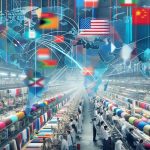You might not know that the textile industry is one of the largest contributors to environmental pollution globally. When you consider sustainable textiles, you're looking at an intricate balance between higher initial production costs and substantial long-term benefits. Businesses adopting sustainable practices can reduce waste and energy usage, ultimately saving money over time. Plus, consumers are increasingly willing to pay a premium for eco-friendly products, which can boost your brand's reputation and market share. Curious about how these elements come together to create economic sustainability? Let's explore the financial dynamics of ethical fabric production further.
Table of Contents
Key Takeaways
- Sustainable textiles reduce long-term costs through waste reduction, energy efficiency, and lower environmental impact.
- Consumers are willing to pay premium prices for eco-friendly and ethically produced textiles.
- Ethical sourcing and production practices enhance brand loyalty and market differentiation.
- Renewable energy and advanced green technologies in textile production improve operational efficiency and sustainability.
- Transparent sustainable practices build consumer trust, justifying higher pricing and fostering brand loyalty.
Market Demand for Eco-Friendly Fabrics
Increasingly, consumers are demanding eco-friendly fabrics as they become more aware of environmental issues. You're likely noticing that the market for sustainable textiles is expanding rapidly. This shift is largely driven by heightened awareness of the environmental impact of traditional fabric production, which can involve harmful chemicals, excessive water usage, and significant carbon emissions.
By choosing eco-friendly fabrics, you're directly influencing the supply chain. Companies are now compelled to source materials that aren't only sustainable but also ethically produced. This means they must consider the entire lifecycle of the fabric—from raw material extraction to manufacturing processes and even disposal methods.
Your demand for greener options pushes manufacturers to adopt practices that reduce waste and minimize pollution.
Understanding the environmental impact of your choices empowers you to make more informed decisions. When you opt for sustainable fabrics, you're not just buying a product; you're advocating for a cleaner, more responsible industry. This advocacy creates a ripple effect throughout the supply chain, encouraging more brands to prioritize sustainability.
Ultimately, your preference for eco-friendly textiles is a powerful tool for driving systemic change in the fashion industry.
Cost Analysis of Sustainable Materials
When comparing costs, you'll notice that sustainable materials can initially appear more expensive than their traditional counterparts. This higher upfront cost often stems from the unique challenges associated with material sourcing and production efficiency. However, a deeper analysis reveals several factors that can influence these costs:
- Material Sourcing: Sustainable textiles often require ethically sourced raw materials, which can be pricier due to limited availability and fair trade practices.
- Production Efficiency: The production processes for eco-friendly materials are typically more sophisticated and less polluting, yet they may also be less streamlined, affecting overall efficiency.
- Cost Savings: Long-term cost savings are achievable through reduced waste and energy consumption, even if initial investments are higher.
- Environmental Impact: Sustainable materials often have a lower environmental impact, mitigating future costs related to environmental damage and regulatory compliance.
Financial Benefits of Ethical Production
You'll find that ethical production can lead to lower operational costs through efficient resource use and waste reduction.
Additionally, adopting ethical practices boosts brand loyalty as consumers increasingly value sustainability.
This approach also allows you to stand out in the market, offering a unique selling point that attracts conscientious buyers.
Lower Operational Costs
By adopting sustainable practices, your textile business can greatly reduce operational costs and boost profitability. Incorporating energy-efficient techniques not only shrinks your carbon footprint but also slashes utility bills. Here's how you can achieve lower operational costs through sustainable methods:
- Energy Efficiency: Upgrading to energy-efficient machinery and optimizing your manufacturing processes can significantly cut down electricity and fuel expenses. Not only will this save money, but it will also make your operations more reliable and productive.
- Waste Reduction: Implementing a waste management system can help you turn textile scraps into valuable resources. By recycling and reusing materials, you'll minimize waste disposal costs and create new revenue streams.
- Water Conservation: Investing in water-saving technologies and practices can substantially reduce water usage and lower your utility bills. Techniques like closed-loop water systems can recycle water within your processes, making your operations more sustainable and cost-effective.
- Supply Chain Optimization: Partner with suppliers who prioritize sustainability to benefit from cost savings on materials and logistics. Sustainable sourcing often means better quality and longer-lasting materials, which can reduce replacement and maintenance costs.
Increased Brand Loyalty
Embracing ethical production practices can greatly enhance brand loyalty and drive financial growth. By integrating sustainable practices into your business model, you can considerably boost customer engagement.
Eco-conscious consumers are increasingly scrutinizing the brands they support, seeking reassurance that their purchases align with their values. When you commit to ethical production, you're not just manufacturing goods; you're building trust.
Your brand reputation stands to benefit immensely from this approach. In today's market, transparency and accountability are highly valued. Consumers want to know the origins of their products and the methods used to create them. By openly sharing your sustainable practices, you foster a sense of community and loyalty among your customers. This, in turn, translates into repeat business and positive word-of-mouth, further bolstering your financial standing.
Moreover, a strong commitment to ethical production can differentiate your brand, making it more appealing to eco-conscious consumers. These consumers are often willing to pay a premium for products that reflect their environmental and ethical standards. As a result, your investment in sustainable practices not only enhances your brand reputation but also directly contributes to your bottom line through increased sales and customer retention.
Market Differentiation Strategies
To stand out in a crowded marketplace, adopting ethical production practices offers a distinct competitive advantage. By focusing on sustainable textiles, you can enhance your brand positioning and attract a growing segment of conscientious consumers. Ethical production isn't just a moral choice; it provides tangible financial benefits.
Here are four key ways it can differentiate your brand:
- Premium Pricing: Consumers are willing to pay more for products they perceive as ethically produced. This allows you to set higher price points, boosting your profit margins.
- Customer Loyalty: Ethical practices foster trust and loyalty, leading to repeat purchases and long-term customer relationships.
- Market Access: Many retailers and online platforms prioritize or exclusively stock brands that meet sustainable criteria, expanding your distribution opportunities.
- Positive Brand Image: Ethical production enhances your brand's reputation, leading to increased media coverage and positive word-of-mouth, which are invaluable for organic growth.
Investment in Green Technologies
When you invest in green technologies, you're setting the stage for integrating renewable energy and implementing waste reduction strategies. These investments not only lower your environmental footprint but also enhance your long-term profitability.
Renewable Energy Integration
Investing in green technologies not only reduces operational costs but also lowers the carbon footprint of textile production. By integrating renewable energy sources, you can greatly enhance energy efficiency in textile production, which is vital for long-term sustainability.
Here's how you can achieve this:
- Solar Panels: Installing solar panels on your facility's roof can generate a substantial portion of your energy needs, cutting down on electricity costs and reducing reliance on fossil fuels.
- Wind Turbines: If your location permits, wind turbines can be an excellent addition. They can supply a noteworthy amount of renewable energy, further lowering your carbon footprint.
- Energy-Efficient Machinery: Upgrading to energy-efficient machines can significantly reduce energy consumption and improve overall operational efficiency.
- Bioenergy Solutions: Utilizing bioenergy from organic waste can provide a sustainable energy source, aligning with sustainable sourcing practices in fabric manufacturing.
Incorporating these renewable energy solutions not only supports a greener planet but also positions your business as a leader in sustainable practices. Mastering the integration of renewable energy into your operations will set you apart in an industry increasingly focused on sustainability. This strategic move isn't just about compliance but about pioneering the future of textile production.
Waste Reduction Strategies
Reducing waste in textile production is crucial, and adopting advanced green technologies can make this objective achievable. You can champion recycling initiatives as a cornerstone of your waste reduction strategy. By implementing a circular economy model, you guarantee that materials are continually reused, reducing the need for virgin resources. This approach not only minimizes waste but also enhances resource efficiency and sustainability.
Investing in upcycling techniques offers another powerful avenue for waste reduction. Instead of discarding textile scraps, you can transform them into new, high-quality products. This method not only curtails waste but also adds value to otherwise discarded materials. Coupled with material innovation, upcycling can lead to the development of novel fabrics that are both sustainable and economically viable.
Material innovation doesn't stop at upcycling. By exploring new, eco-friendly materials, you can reduce the environmental impact of textile production from the outset. For instance, biodegradable fabrics and low-impact dyes can greatly cut down on both waste and pollution.
Essentially, integrating green technologies and adopting a holistic approach to waste reduction won't only align your practices with sustainability goals but also position you at the forefront of the textile industry's future.
Consumer Willingness to Pay Premium
Understanding consumer willingness to pay a premium for sustainable textiles is essential for businesses aiming to tap into environmentally conscious markets. You need to grasp how the sustainability impact influences consumer behavior and why people are willing to spend more on eco-friendly products.
- Perceived Value: Consumers often equate higher prices with better quality and greater sustainability impact. They believe that by paying more, they're contributing to a larger environmental cause.
- Brand Trust: When brands are transparent about their sustainable practices, it builds consumer trust. This trust can justify higher prices, as consumers feel confident that their money supports genuine environmental efforts.
- Social Influence: Consumers are swayed by social trends and peer behavior. If eco-friendly products are popular within their social circle, they're more likely to spend extra to align with these norms.
- Emotional Satisfaction: There's an emotional reward in making sustainable choices. Consumers who feel good about their purchases are willing to pay more for that sense of satisfaction.
Long-Term Economic Sustainability
Ensuring long-term economic sustainability in the textile industry requires a balanced approach that integrates both environmental stewardship and financial viability. You need to focus on supply chain optimization to minimize waste and enhance efficiency.
By adopting circular economy models, you can confirm materials are reused and recycled, reducing dependency on virgin resources and cutting costs over time.
Sustainable sourcing is another vital element. You must prioritize materials that aren't only eco-friendly but also durable, confirming they withstand multiple life cycles.
This practice not only supports environmental goals but also reinforces the economic aspect by reducing the frequency and cost of material procurement.
Ethical labor practices are non-negotiable for long-term sustainability. Fair wages, safe working conditions, and respect for workers' rights contribute to a more stable and productive workforce.
This stability can lead to lower turnover rates and higher-quality output, ultimately benefiting your bottom line.
Incorporating these strategies creates a robust framework that supports both profitability and environmental responsibility.
Frequently Asked Questions
What Are the Environmental Impacts of Conventional Textile Production?
You'll find that conventional textile production greatly harms the environment by increasing carbon emissions and water pollution. It also contributes to soil degradation and deforestation, leading to long-term ecological damage and biodiversity loss.
How Do Sustainable Textiles Affect Global Supply Chains?
Imagine a transparent tapestry. By embracing sustainable textiles, you guarantee supply chain transparency, ethical sourcing, and fair labor practices. You'll unravel hidden costs and weave a more responsible, equitable global market. Mastery awaits those who commit.
Are There Any Government Policies Promoting Sustainable Textile Practices?
You'll find various government incentives promoting sustainable textile practices. These policies often encourage industry collaborations to reduce environmental impact. To master this area, stay updated on evolving regulations and leverage available resources for sustainable innovation.
What Role Do Certifications Play in the Sustainable Textile Industry?
Certifications have a substantial impact on the sustainable textile industry by ensuring industry standards are met. You'll find that they enhance consumer trust, guarantee product authenticity, and encourage manufacturers to adopt eco-friendly practices, fostering a more sustainable market.
How Can Consumers Identify Genuinely Sustainable Textile Products?
Don't judge a book by its cover. To identify genuinely sustainable textile products, focus on consumer education and eco-friendly choices. Watch out for greenwashing and prioritize transparent labeling to guarantee you're making informed, sustainable decisions.
- Tetron Fabric for Marine Applications: Durability and Use Cases - June 18, 2025
- Tetron Fabric for Outdoor Furniture: Weather Resistance and Care - June 18, 2025
- Tetron Fabric for Wall Coverings: Style and Application Tips - June 18, 2025







